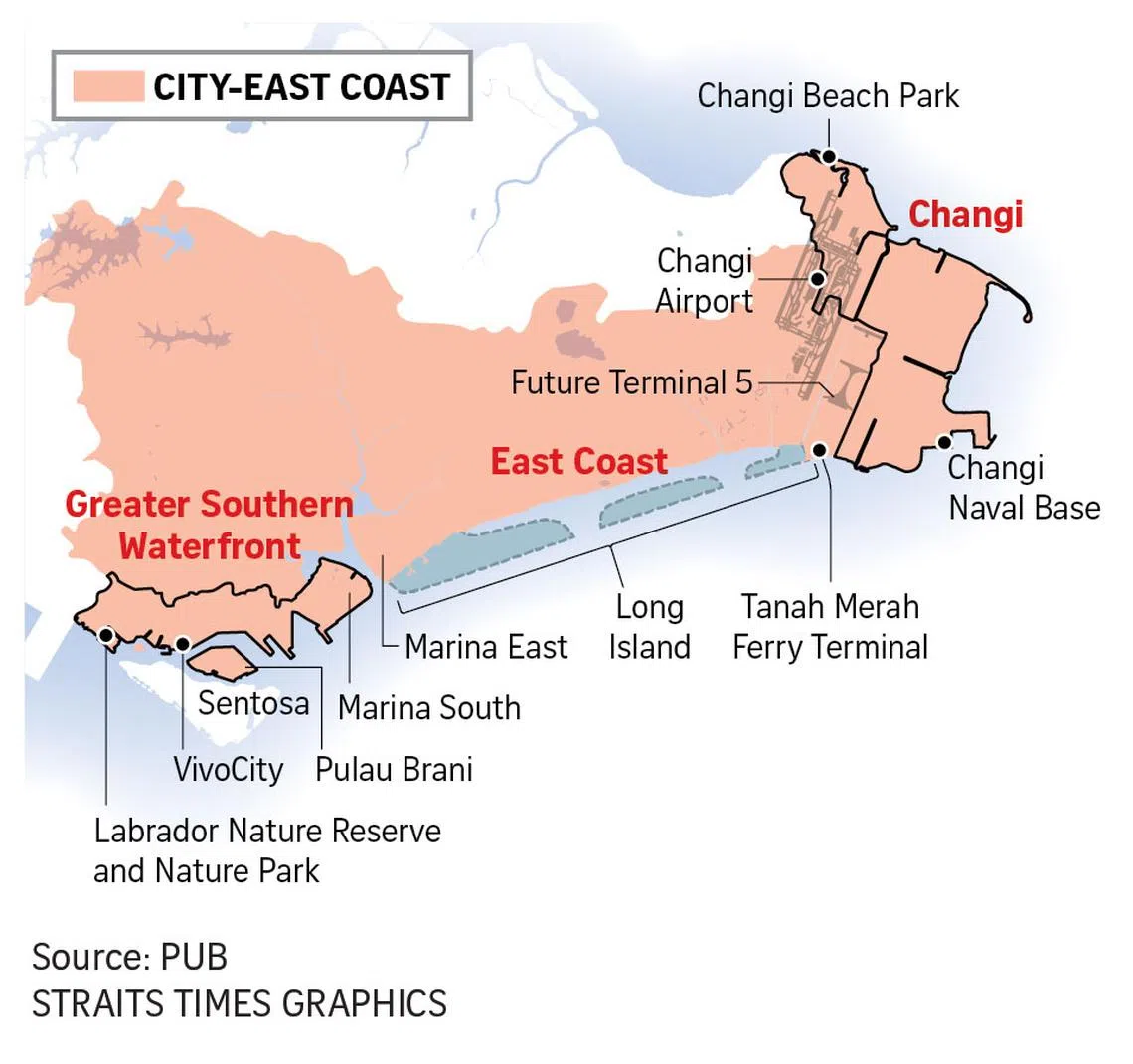S’pore’s south-eastern coastline to be protected from rising seas by coastal barriers, tidal gates
Sign up now: Get ST's newsletters delivered to your inbox

An artist’s impression of a possible coastal barrier which also provides enhanced transport connectivity between Sentosa and Pulau Brani.
PHOTO: PUB
Follow topic:
- Singapore will implement coastal protection measures like storm surge barriers and raised platforms at Greater Southern Waterfront and Changi by the 2030s to combat rising sea levels.
- Changi Beach Park will use a raised platform inland, allowing for temporary flooding to preserve intertidal areas while ensuring public safety with timely beach closures.
- PUB aims to balance technical feasibility, cost, and biodiversity impact when constructing coastal barriers, consulting with environmental groups and integrating future developments.
AI generated
SINGAPORE – Structures to help preserve Singapore’s south-eastern coastline – one of its lowest-lying areas – will be built from the 2030s to protect people and infrastructure there from the rising seas.
These range from coastal barriers, which are arm-like gates that can open or close depending on weather conditions, to raised platforms known as bunds in the Changi beach area.
These were some of the proposed solutions revealed at the country’s first coastal protection exhibition at VivoCity.
On Aug 30, Deputy Prime Minister Gan Kim Yong, who toured the exhibition, said: “Coastal protection is another endeavour that will require sustained effort over generations – and just as with our public housing, water and infrastructure, it is a necessary investment in the safety, security, and resilience of our nation.”
The exhibition ends on Aug 31.

(From second from left) DPM Gan Kim Yong, Minister for Sustainability and the Environment Grace Fu and PUB chief executive Ong Tze-Ch’in at the inaugural Coastal Protection Exhibition on Aug 30.
ST PHOTO: AZMI ATHNI
The proposed measures shown at the exhibition by national water agency PUB are recommendations following a four-year study of the City-East Coast stretch. The study by infrastructure consultancy CPG Consultants began in 2021.
The stretch spans the Pasir Panjang Ferry Terminal to the future Greater Southern Waterfront precinct and the Changi area.
It is one of eight segments into which PUB has divided Singapore’s over 300km-long coastline to identify the most suitable ways to protect each section.
The City-East Coast stretch was chosen for the first site-specific study due to its low-lying nature as much of it is less than 5m above current sea levels.
By 2100, average sea levels around Singapore could potentially rise by up to 1.15m.
The segment between the Greater Southern Waterfront and Changi will be protected by the previously announced Long Island.

Long Island is envisioned as three tracts of land reclaimed to higher levels off East Coast. It will protect a large part of the City-East Coast stretch, from Marina East to Tanah Merah Ferry Terminal, from rising seas.
Protection measures for other parts of the Greater Southern Waterfront and Changi include installing seawalls, raising shoreline slopes and building tidal gates.

Tidal gates built at canal outlets will close during high tide and extreme coastal weather to keep seawater out.
This menu of solutions, tailored to the characteristics of every part of the coastline, will form a continuous line of defence from Pasir Panjang Ferry Terminal to Changi beach.

“Every stretch of our coast is different – from the bustling Marina Bay to the tranquil Changi Beach Park. Each coastal space has its own geography, uses and identity,” added DPM Gan, who is also Minister for Trade and Industry.
In the next one to two years, PUB and other agencies will do further studies, which include developing the designs of the recommended measures and conducting environmental impact assessments.
First-in-Singapore coastal barriers
Three barriers will be installed on both ends of Sentosa to shield the coastline from storm surges.
Storm surges are higher-than-usual tides caused by storms brewing offshore, with sea levels rising up to 4m or 5m and leading to coastal flooding.

Each barrier comprises a series of gates across the water channels.
There could be two coastal barriers on the eastern end of Sentosa.
One will link the resort island to Pulau Brani, and another from Brani to mainland Singapore. Brani, now a port island, will be turned into a leisure destination in the next two to three decades under the Greater Sentosa Master Plan.
Agencies will further study the possibility of having the barriers also serve as a “causeway” for visitors to reach Brani and Sentosa from the mainland.
The third coastal barrier will connect western Sentosa to a yet-to-be determined location on the mainland because environmental impact studies have to be done first.

Sentosa’s western end faces Labrador Nature Reserve’s Berlayer Creek – home to one of two remaining mangrove patches in the south of Singapore.
The resort island’s western corner is also home to Tanjong Rimau, one of Singapore’s last remaining rocky shores.
Building the barrier at the narrowest parts of the channel may be less costly and reduce time, but could risk impacting the habitats. PUB said it will explore solutions that balance technical feasibility, cost and impact on biodiversity.
PUB said it had previously considered an alternative approach to protecting the Greater Southern Waterfront which involves raising seawalls and constructing tidal gates along the entire waterfront promenade.
However, this would block sea views and take up more waterfront land.
Agreeing, exhibition visitor and Telok Blangah resident Herman Khoo, 75, said: “Seawalls will destroy the aesthetics of the place. The waterfront should be freed up for residential (uses) and leisure.”
Storm surge barriers already exist in places like the Netherlands and Britain. In the 1990s, the Maeslant barrier – one of the largest moveable objects in the world – was built to protect Rotterdam and its port from storm surges.

Shielding eastern Changi
Over at Changi Beach Park, considered a treasure trove of intertidal biodiversity, PUB said it will be constructing a raised platform – such as a bund – farther inland to ensure access to the beach and preserve the seagrass-rich shores.
This means the beach will be left to temporarily flood during extreme high tides. Safety measures will be put in place to guide beachgoers away when extreme coastal weather is forecast.

PUB said it had incorporated feedback from the community and nature groups to preserve habitats and visitor access in deciding on this measure.
Mr Muhammad Nasry Abdul Nasir, executive director of Singapore Youth Voices for Biodiversity, said: “Let the tidal areas flood. That’s what they do. I would prefer if the bund is set as far back as possible inland to allow intertidal areas and seagrass meadows to retreat with sea level rise.”
Mr Ho Xiang Tian, co-founder of environmental group LepakInSG, said: “I’m glad to hear this because our shorelines are being squeezed everywhere and this gives some breathing room for the Changi intertidal shores.”
Coastal protection will also be integrated into future developments in the area. For example, Changi Airport’s upcoming fifth terminal will have an elevated airfield at 5.5m above sea level.

“Where feasible, we will raise the cycling paths along our shores so that they can also double up as our coastal defences,” said DPM Gan, adding that Changi will be turned into a vibrant business and lifestyle destination.
A mix of funding methods will be used to finance the coastal measures, said PUB.
This includes tapping the $10 billion Coastal and Flood Protection Fund, as well as earmarking funds for this purpose in the annual Budget. The Government will also consider borrowing to spread the cost across generations, PUB added.
At the VivoCity exhibition, several visitors said they appreciated Singapore’s foresight in planning for future sea level rise.
Retiree Terin Yim, who frequently visits Changi Beach Park with her husband, said: “We are already in our 60s, but we worry about the younger generation. We are glad that the authorities are pre-emptive and not reactive.”


